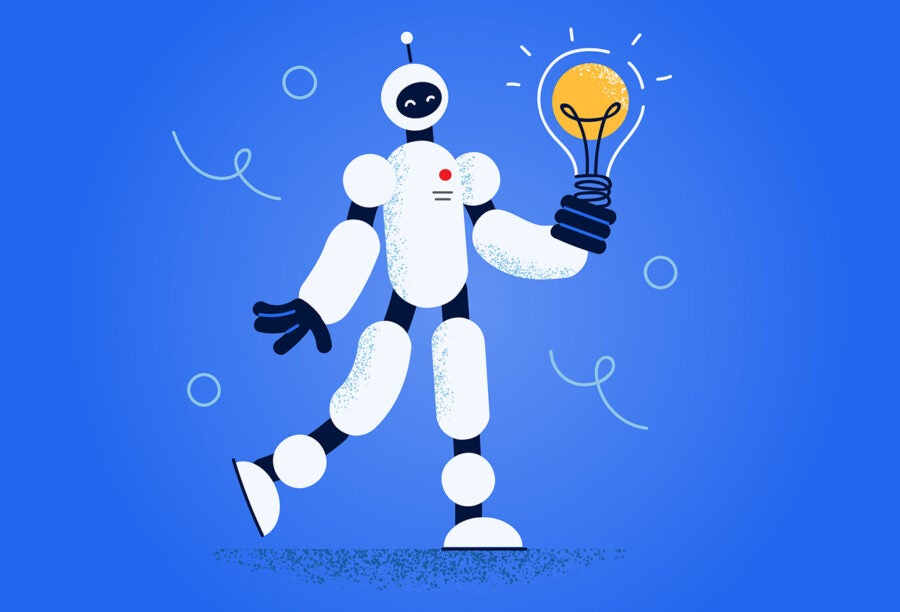The following article was written by Scott A. Snyder, a senior fellow at Wharton, adjunct professor at Penn Engineering, and chief digital officer at EVERSANA; and Sophia Velastegui, AI business leader and AI advisor at the National Science Foundation, as well as former general manager and chief AI technology officer at Microsoft. Editor’s Note: Velastegui has worked at multiple companies in the “Magnificent Seven” — Apple, Amazon, Alphabet, Meta, Microsoft, Nvidia, and Tesla — a group of high-performing, influential stocks nicknamed for their leadership in AI and the tech sector.
With over 180 million users for ChatGPT alone, generative AI (gen AI) has already garnered a massive user base utilizing its capabilities for everything from personal productivity to content creation to launching new ventures — all accomplished at a fraction of the time and cost. Every week, studies show gen AI models excelling at tasks that were previously deemed exclusive to human intellect and ingenuity, such as medical and legal exams, innovation tournaments, financial advice, and business case analyses. The advent of multimodal models like GPT-4 and Gemini Advanced further elevates these capabilities, enabling more human-like interactions than ever before.
As this technological bullet train speeds down the tracks, consider the five myths outlined below. These myths are not intended to halt progress but rather serve as cautionary flags along the path to integrating gen AI into your organization. Proactively addressing these misconceptions will enable you to mitigate the challenges you’ll encounter as you harness this transformative technology.
Myth #1: Gen AI Tools Are Available for Free or Minimal Cost
Developing your own proprietary gen AI model can enable you to more precisely meet your company’s needs and align with your business processes and workflows, but this solution is cost-prohibitive for most organizations. The development process requires significant investments in talent, resources, and infrastructure. Additionally, ongoing maintenance and updates can further add to the total cost of ownership. For many organizations, leveraging third-party AI solutions or partnering with specialized providers may offer a more cost-effective approach to achieving their goals.
Even so, third-party AI solutions require investment. Older iterations of OpenAI’s ChatGPT are available at minimal cost, whereas the latest and most advanced version, GPT-4, incurs a $20/month subscription fee. When integrated into Microsoft’s suite via Copilot, the cost rises to $30/month per employee for companies. For enterprises with thousands of employees, this can result in an annual expenditure exceeding millions of dollars for a platform still in its pilot stage, with limited demonstration of wide-scale impact. These fees are not unexpected considering OpenAI’s substantial investment of over $100 million to train GPT-4, alongside Microsoft’s $13 billion investment in OpenAI plus the additional expenses incurred to integrate into Microsoft platforms, but they will certainly put pressure on enterprises to show a near term return on their investment.
Google’s new Gemini Advanced follows a comparable pricing structure, at $29 per month after a two-month free trial. On the other hand, open-source models like Llama and Mistral are available for free download but require companies to set up their own infrastructure, security protections, and model development environments. In contrast, enterprise gen AI platforms from cloud vendors like Google’s VertexAI, Microsoft’s Azure AI, or AWS’s Bedrock already include these features. Once you factor in additional expenses such as API and model usage fees, as well as the additional cloud infrastructure required to facilitate new gen AI deployments — including tuning, optimization, and support — total investments can escalate to millions of dollars per model, depending on the level of customization required.
Myth #2: AI Always Improves Human Performance
A recent BCG study revealed that 90% of consultants utilizing GPT-4 for creative product innovation experienced a remarkable 40% improvement in performance compared to those not leveraging the technology. However, consultants using GPT-4 for business problem-solving showed a 23% decrease in performance compared to the control group, with less-experienced workers performing even worse. This serves as a reminder that while gen AI holds immense potential, its accuracy may vary, particularly in domains where there are insufficient training data and less-experienced workers.
The key factor for success when working with gen AI lies in training employees in essential soft skills such as critical thinking, judgment, empathy, and bias detection to effectively task models and evaluate their results. It’s important to recognize that gen AI operates based on the most likely arrangement of words or pixels derived from its training data and prompts. It doesn’t possess intrinsic understanding or intent. As AI assumes more responsibilities, the human-in-the-loop becomes a mission-critical step, focused on diminishing the window of time needed for human interaction to still ensure reliable, fair, and useful outcomes.
“As much as 50% of the effort in successfully deploying new AI models goes beyond technical implementation.”
Myth #3: Building the Gen AI Model Is the Hardest Part of Implementation
Customizing pre-trained models — such as ChatGPT, Gemini, Claude, or Llama — to specific company use cases and datasets requires significant effort, utilizing techniques such as fine-tuning or Retrieval Augmented Generation (RAG). In addition, preparing datasets for gen AI model consumption, implementing privacy and security safeguards, and productizing the deployment and support of these models are time and resource-intensive tasks. Risks such as jailbreaking (malicious actors getting access to the underlying system), prompt injection (harmful instructions leading AI to generated unwanted content), and poisoning (manipulating training data to introduce biases or distort behavior of the AI model) pose significant threats, highlighting the importance of robust data protection measures, especially in light of regulations such as the EU’s AI Act.
However, as much as 50% of the effort in successfully deploying new AI models goes beyond technical implementation — it involves transforming the way people work. This requires significant effort in changing management to ensure that employees are prepared for and receptive to the adoption of AI solutions. For example, in customer service automation, employees may need to adapt their workflows to incorporate AI assistance, including identifying and addressing any potential ‘hallucinations’ or inaccuracies in the AI-generated responses. This involves rethinking how tasks are performed, understanding how to effectively delegate tasks to AI systems, and interpreting and acting upon AI-generated outputs. It is these significant activities beyond the model itself that cause typical AI deployments to take as long as 6-18 months.
Myth #4: You Can Wait and See How Gen AI Plays Out Before Making a Move
With the rapid emergence of gen AI and the uncertainty surrounding its adoption and impact, companies might be tempted to run a few pilots and adopt a wait-and-see approach before making broader investments. However, history offers lessons from successful companies that have been blindsided by breakthrough technological waves, rendering their existing business and operating models obsolete within just a few decades.
Companies frequently find themselves caught off guard by disruption, as seen with JCPenney and Circuit City being crushed by Amazon and e-commerce during the retail apocalypse, or Nokia and RIM/BlackBerry faltering against the iPhone and app store model. Gen AI’s exponential growth potential suggests it could be the next “iPhone moment,” fundamentally altering customer expectations and how companies deliver value in the future. The critical question shouldn’t be whether we can afford to invest in pursuing new gen AI opportunities, but rather, can we afford not to?
Myth #5: Investing in Gen AI Will Automatically Give You a Competitive Advantage
As organizations adopt gen AI to improve their operations and gain a competitive edge, they often enjoy initial benefits from being early adopters and implementing innovative strategies. However, as gen AI technologies become more widely accessible, competitors can quickly catch up by using similar tools and approaches. This highlights the temporary nature of the advantages gained from deploying gen AI.
To maintain a sustainable advantage in the market, organizations must realize that merely deploying gen AI technology is not enough. They must continuously innovate, differentiate, and evolve their gen AI strategies to outpace competitors. Additionally, organizations need to recognize the value of proprietary data as a strategic asset. While gen AI platforms offer access to pre-built models and tools, the real value lies in the data used to train and customize these models. Even Google, a tech giant known for innovation, isn’t immune to losing its competitive edge, as evidenced by recent news around Microsoft. Despite Google’s longstanding dominance in the search market, Google missed opportunities by not capitalizing on gen AI–driven search features. While Google focused on preserving its stronghold in traditional search, competitors such as OpenAI seized the chance to invest in gen AI–powered interfaces, recognizing their potential to revolutionize search experiences.
“The critical question shouldn’t be whether we can afford to invest in pursuing new gen AI opportunities, but rather, can we afford not to?”
How to Navigate the Myths and Bring Gen AI Solutions to Life
1. Utilize scenario planning to anticipate and prepare for various potential outcomes or applications of gen AI
A scenario lens can help companies set the right strategic direction while also placing the right bets that allow them to position for a range of AI futures in their industry. This could involve a combination of “no regret” capabilities coupled with internal and external “experiments” to learn and adapt quickly. By employing this approach, organizations can mitigate risks, allocate resources effectively, and ensure that the overall AI strategy and portfolio align with the organization’s goals and mission.
2. Prioritize your gen AI opportunities using the “Three Rs”
Responsibility: Ensure your company has established clear guidelines for developing AI solutions that are fair, transparent, ethical, and safe. This foundational step sets the groundwork for responsible AI deployment.
Reliability: Select use cases that can tolerate the potential risk of errors introduced by AI. Starting with non-mission-critical use cases allows you to build momentum and gain confidence in the technology’s reliability over time.
ROI: Evaluate the financial benefits of the gen AI solution, along with non-financial advantages such as improved customer satisfaction, speed to market, and retention. Consider the full life cycle costs to make informed decisions about the overall value proposition of gen AI integration.
3. Evaluate your organization’s readiness for AI across multiple dimensions
This includes strategy, execution, innovation, and agility, using tools like the AI Readiness Quotient. This will help identify both strengths you can build on as well as gaps that need to be addressed in order to shift to an AI-first organization and operating model. Establishing this baseline allows for periodic measurement of progress throughout your AI journey.
Misconceptions surrounding gen AI can cloud perceptions and hinder clear decision-making. Organizations that effectively dispel the five myths and embrace the reality of gen AI gain a competitive advantage. By leveraging accurate insights and understanding of gen AI, organizations can capitalize on opportunities, drive innovation, and stay ahead of competitors in the rapidly evolving landscape of AI technologies.



